Effect of Silane Coupling Agent on Modification of Areca Fiber/Natural Latex
Abstract
:1. Introduction
2. Materials and Methods
2.1. Materials
2.2. Experiment Formulation
2.3. Preparation of Areca Fiber by Hot Alkali Method
2.4. Pretreatment of Silane Coupling Agent
- Since Si−69 and KH570 are insoluble in water, it was necessary to prepare acetic acid with a concentration of 0.1%, before slowly adding the silane coupling agent and agitated aqueous solution quickly to prevent gel formation [9]. After dripping, the solution was shaken by ultrasound for 10 min until it was completely transparent. If impurities occurred, the solution would be filtered with a 0.5 sieve;
- KH550 is an amino functional silane, which can be directly dissolved in water to prepare 1% aqueous solution, before being placed through ultrasonic vibration for 10 min to ensure uniform dispersion.
2.5. Modification Principle of Silane Coupling Agent
2.6. Preparation of Areca Fiber Latex Composite
2.7. Experimental Process
2.8. Swelling Property of Adhesive
3. Results
3.1. Chemical Bonding Analysis of Areca Fiber Prepared By Hot Alkaline Method
3.2. The Effects of Silane Coupling Agent on the Vulcanization Properties of Composite Materials
3.3. The Effects of Different Silane Coupling Agents on the Physical Properties of Compound
3.4. The Effects of Different Silane Coupling Agents on the Processing Performance of Areca Fiber/Natural Latex
3.5. The Effects of Different Silane Coupling Agents on the Swelling Properties of Areca Fiber/Natural Latex
3.6. The Effects of Different Silane Coupling Agents on the Dynamic Mechanical Properties of Areca Fiber/Natural Latex
3.7. Effects of Different Silane Coupling Agents on the Microstructure of Areca Fiber/Natural Latex
4. Conclusions
Author Contributions
Funding
Acknowledgments
Conflicts of Interest
References
- Zhang, P.; Wen, S.; Zhang, L.; Xu, R.; Liu, L. Structure and properties of silica ultrafine fiber/neoprene composites. China Rubber Ind. 2012, 59, 133–137. (In Chinese) [Google Scholar]
- Zhang, D.; Wang, C.; Wei, G. Effect of short fiber dosage on the mixing quality of short fiber-rubber composites. China Rubber/Plast. Technol. Equip. 2012, 1, 26–29. (In Chinese) [Google Scholar]
- Chen, X.; Wang, C. The effect of the amount of polyester staple fiber on the performance of SFRC. China Tire Ind. 2008, 7, 411–414. (In Chinese) [Google Scholar]
- Wang, D. Study On the Friction and Wear Properties of Nanoparticle-Fiber/Epoxy Based Materials. Master’s Thesis, Tianjin University of Technology, Tianjin, China, 2017. (In Chinese). [Google Scholar]
- Wu, W.; Zhang, J. Preparation of Waste Tire Powder/Plant Fiber Composites and Its Property. Pap. Pap. Mak. 2013, 7, 40–42. (In Chinese) [Google Scholar]
- Liu, X. Preparation and Performance of the Adsorption Type Ternary Ethylpropyl Water Treatment Composite Material. Ph.D. Thesis, Jilin University, Changchun, China, 2009. (In Chinese). [Google Scholar]
- Xiang, X.; Zhao, W. Research on the modification of PVA coating liquid. Packag. J. 2011, 3, 33–38. (In Chinese) [Google Scholar]
- Wang, L.; Wang, Y.; Zhao, X.; Han, Z. Comparative Study on the Method of Extracting Straw Cellulose. Chin. Agric. Sci. Bull. 2013, 29, 130–134. (In Chinese) [Google Scholar]
- Xiong, R.; Zhang, X.; Tian, D.; Zhou, Z.; Lu, C. Comparing microcrystalline with spherical nanocrystallinecellulose from waste cotton fabrics. Cellulose 2012, 19, 1189–1198. [Google Scholar] [CrossRef]
- Wang, X.; Ma, G.; Sun, Y.; Zhang, Y. Study on the effect of S-doped nano-TiO2 on electronic structure and photocatalytic activity. Mater. Rep. 2014, 28, 19–22. (In Chinese) [Google Scholar]
- Wu, W.; Wang, J. Compatibilized fly ash/waste rubber powder composite material with silane coupling agent KH-550 and Si-69. China Synth. Rubber Ind. 2012, 35, 133–136. (In Chinese) [Google Scholar]
- Jin, F. Preparation of Functionalized Graphene and Performance Study of its Composite Materials. Master’s Thesis, Shandong University of Technology, Zibo, China, 2016. [Google Scholar]
- Fang, Z.; Yin, J.; Zhang, Y.; He, P. Preparation and properties of reduced graphene oxide/natural rubber-nitrile rubber composites. Acta Mater. Compos. Sin. 2018, 35, 1253–1259. [Google Scholar]
- Vázquez, A.; Domínguez, V.A.; Kenny, J.M. Bagasse Fiber-Polypropylene Based Composites. J. Thermoplast. Compos. Mater. 1999, 12, 477–497. [Google Scholar] [CrossRef]
- Sain, M.; Panthapulakkal, S. Bioprocess preparation of wheat straw fibers and their characterization. Ind. Crop Prod. 2006, 23, 1–8. [Google Scholar] [CrossRef]
- Valadez-Gonzalez, A.; Cervantes-Uc, J.; Olayo, R.; Herrera-Franco, P. Effect of fiber surface treatment on the fiber–matrix bond strength of natural fiber reinforced composites. Compos. Part B: Eng. 1999, 30, 309–320. [Google Scholar] [CrossRef]
- Mwaikambo, L.Y.; Ansell, M.P. Chemical modification of hemp, sisal, jute, and kapok fibers by alkalization. J. Appl. Polym. Sci. 2002, 84, 2222–2234. [Google Scholar] [CrossRef]
- Payne, A.R. The dynamic properties of carbon black-loaded natural rubber vulcanizates. Part I. J. Appl. Polym. Sci. 1962, 6, 57–63. [Google Scholar] [CrossRef]
- Payne, A.R.; Whittaker, R.E. Low strain dynamic properties of filled rubbers. Rubber Chem. Technol. 1998, 71, 440–478. [Google Scholar] [CrossRef]
- Huang, J.; Huang, B.; Zhao, W.; Min, M.; Li, K.; Li, S.; Wang, H.; Zhang, C. Optimization process of the ultrasonic coupling agent polyacrylamide hydrogel and its acoustic performance characterization. Chin. J. Tissue Eng. Res 2019, 23, 1533–1539. [Google Scholar]
- Ling, X.; Luo, J.; Zou, L.; Wu, J. Application of plant-based environmentally friendly rubber oil in nitrile rubber. China Rubber Ind. 2014, 61, 412–416. (In Chinese) [Google Scholar]
- Wu, W.; Feng, H.; Wang, H. Preparation and characterization of basalt short fiber/silicone rubber/fluororubber composite materials. China Elastomeric 2015, 25, 42–46. (In Chinese) [Google Scholar]
- Lin, Y. Preparation, Structure and Performance of NR/nSiO_2 and NR/Carbon Black Composite Materials by Wet Refining. Ph.D. Thesis, South China University of Technology, Guangzhou, China, 2013. (In Chinese). [Google Scholar]
- Wu, Y. Preparation of ultra-high molecular weight polyacrylonitrile copolymer by aqueous suspension polymerization and its properties. Master’s Thesis, Donghua University, Shanghai, China, 2012. (In Chinese). [Google Scholar]
- Li, R. Synthesis of End-Capped Mercaptosilane Coupling Agent and Its Performance in Silica-Reinforced Styrene-Butadiene Rubber. Master’s Thesis, Zhejiang University, Hangzhou, China, 2007. (In Chinese). [Google Scholar]
- Wang, P.; Lu, A.; Chen, X.; Wang, G.; Zhang, Q. Tribological properties of polyamide 66 modified glass fiber reinforced polyphenylene sulfide system. China Plast. 2008, 22, 43–46. (In Chinese) [Google Scholar]
- Wang, C.; Liu, J.; Song, F.; Bian, H.; Hu, Y.; Liang, D. Preparation of graphene oxide-SiO2/natural rubber composites by atomization sputtering drying method. Acta Mater. Compos. Sin. 2018, 35, 2116–2123. [Google Scholar]
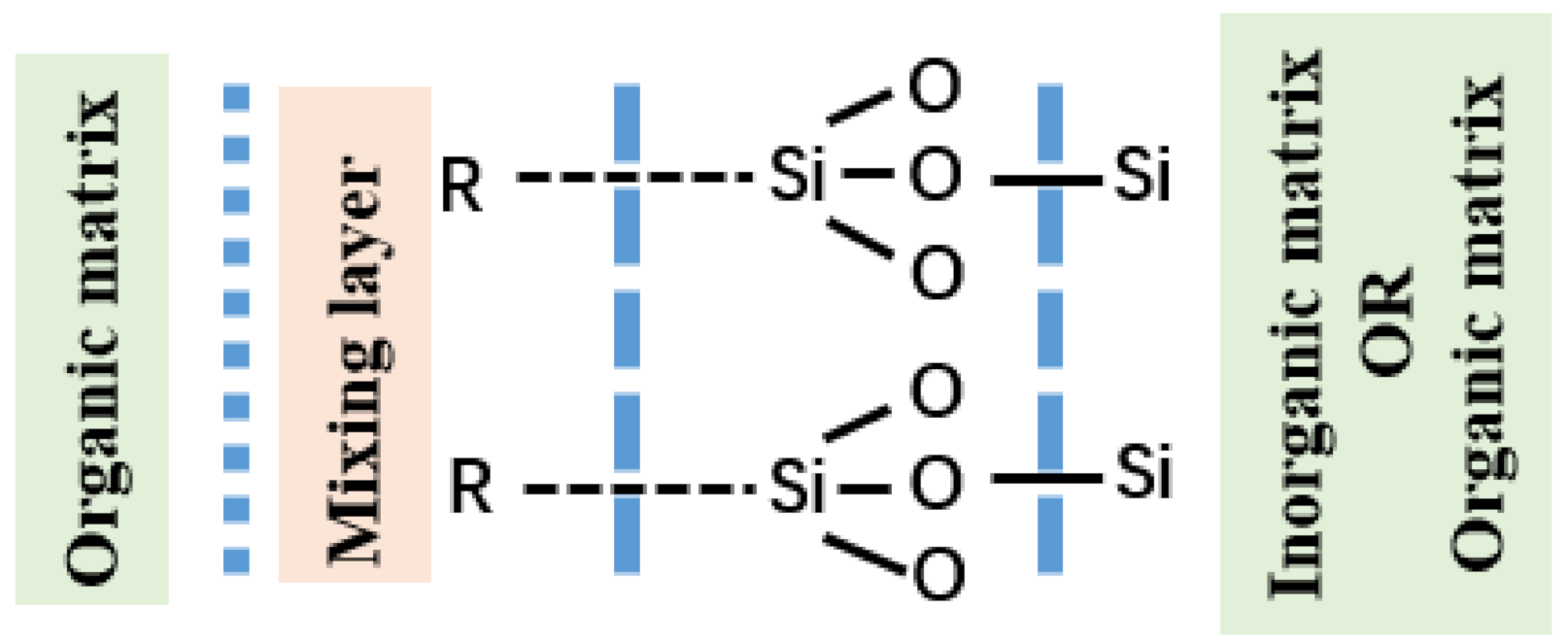

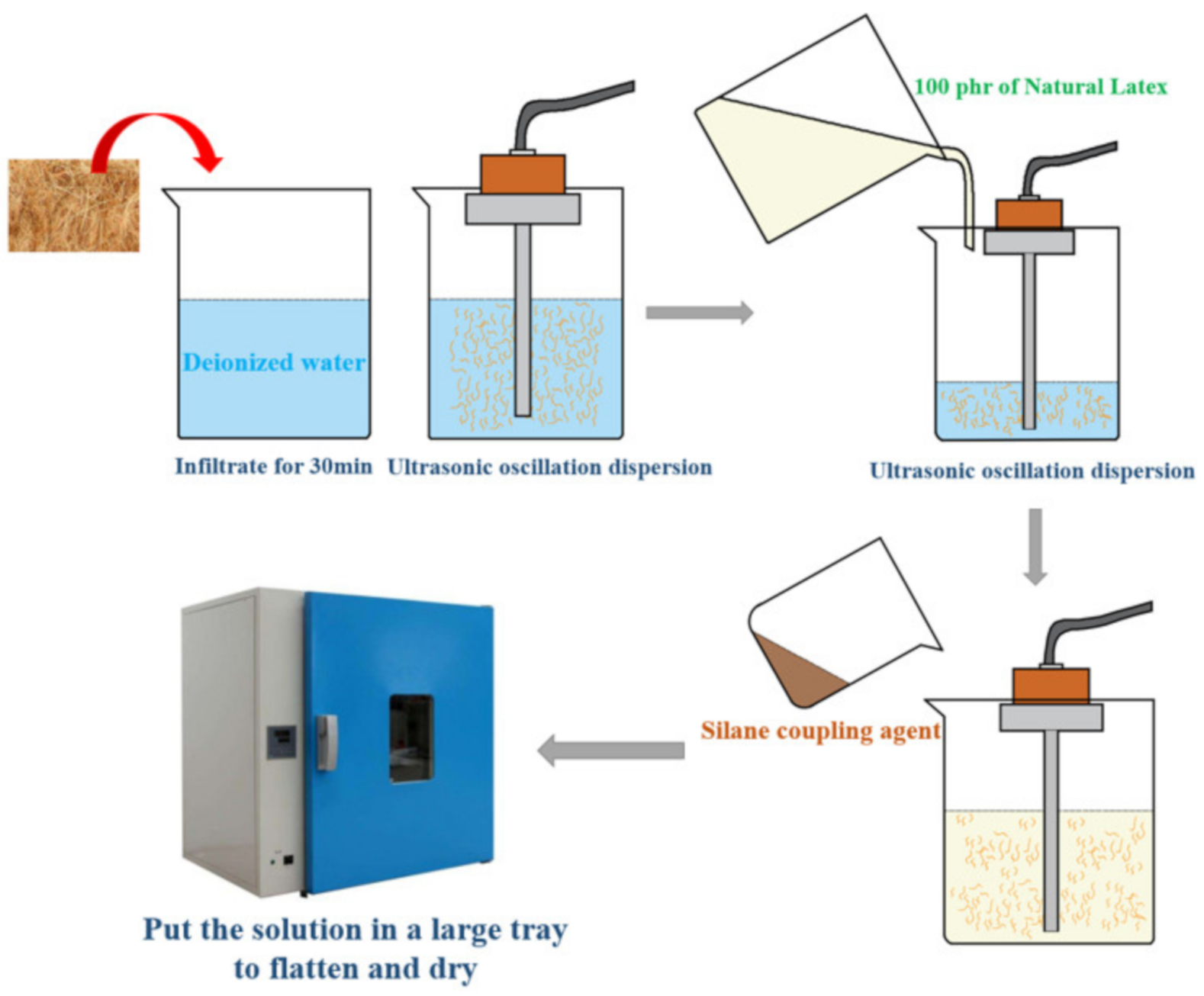
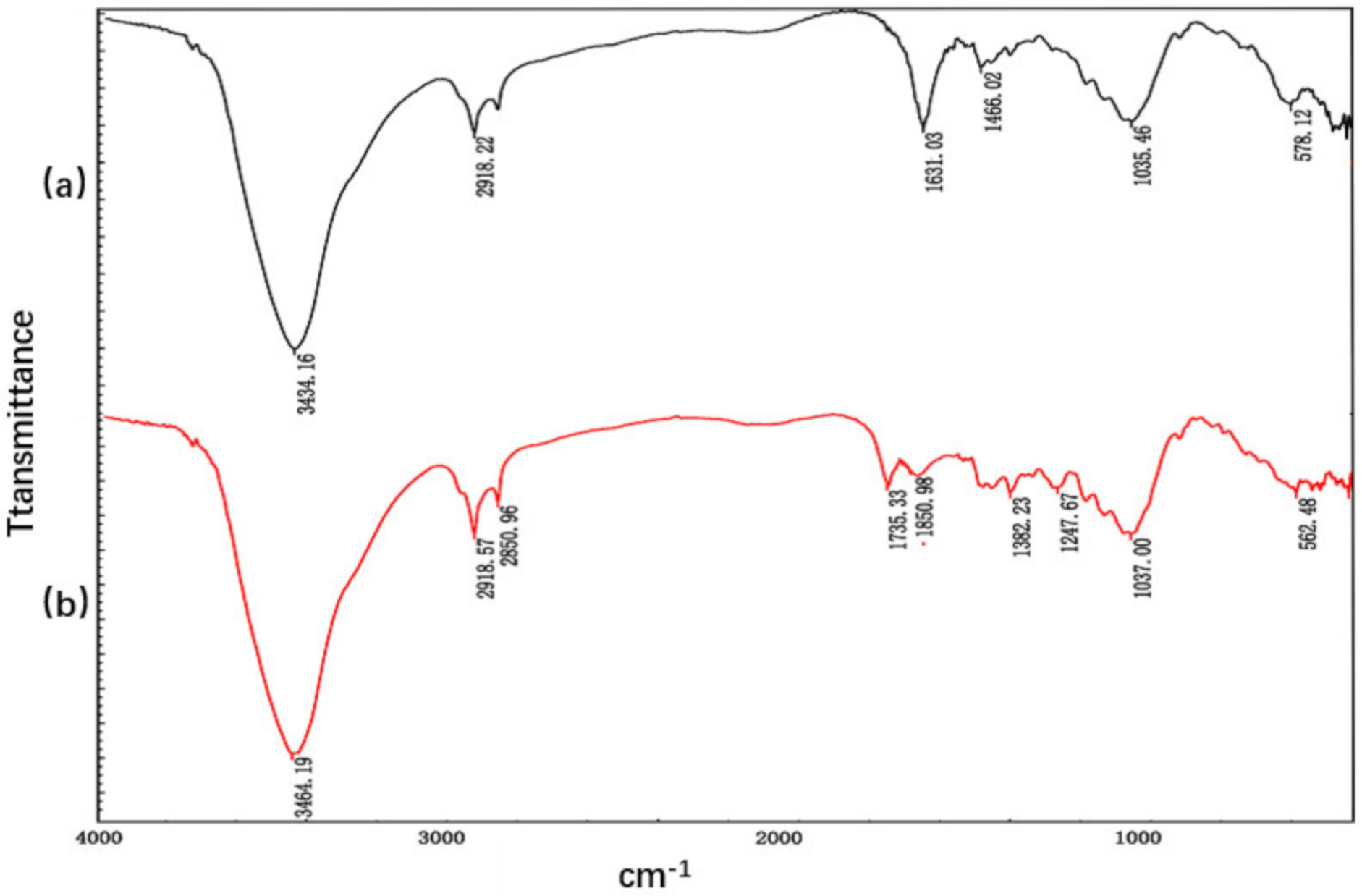
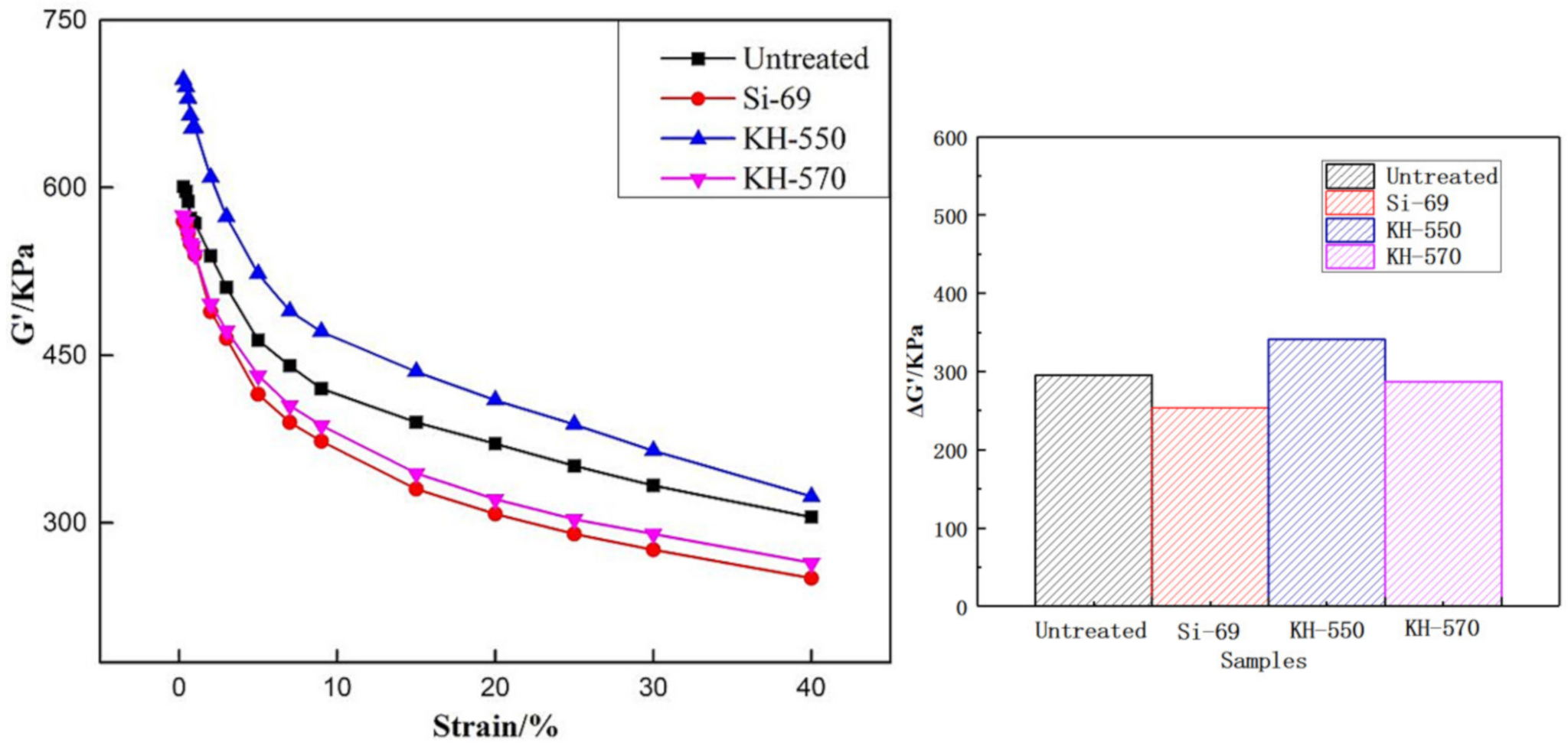
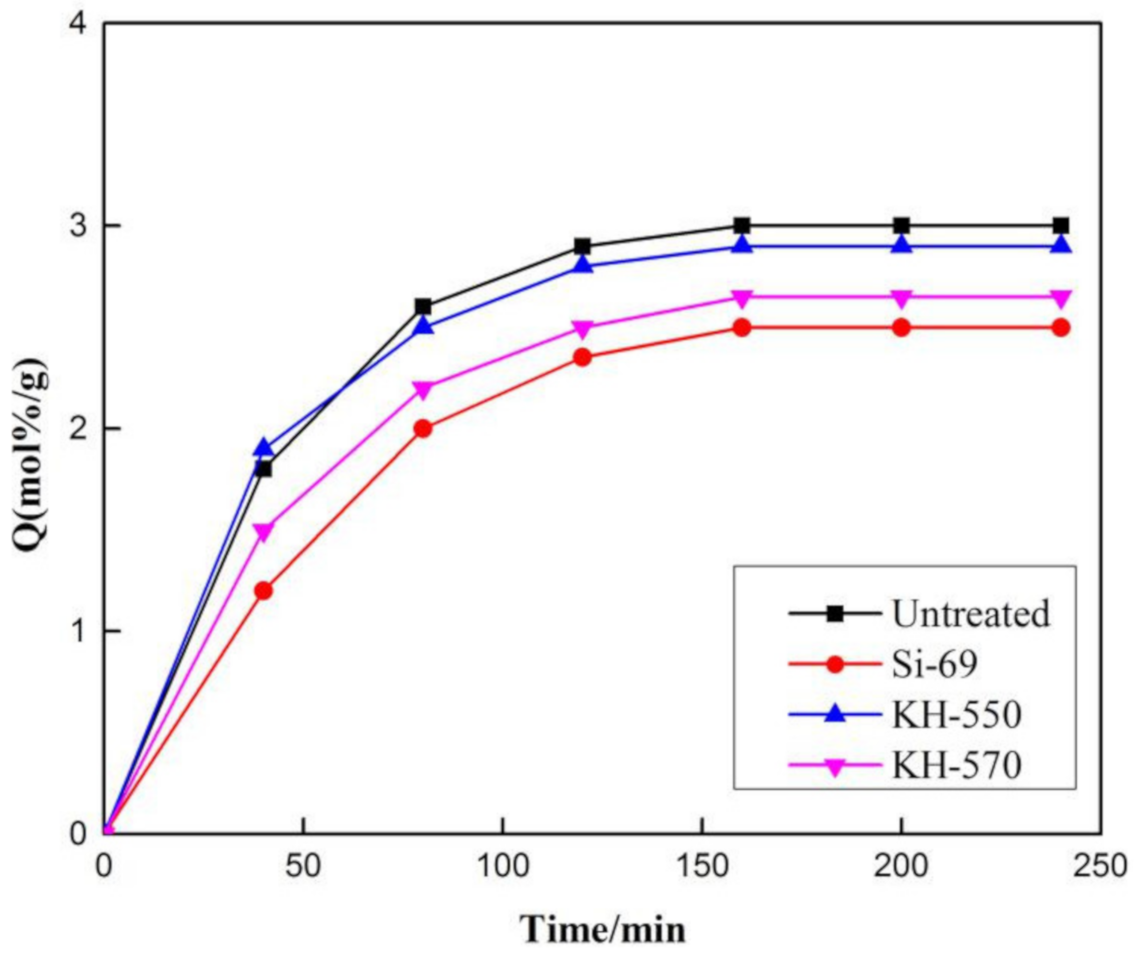
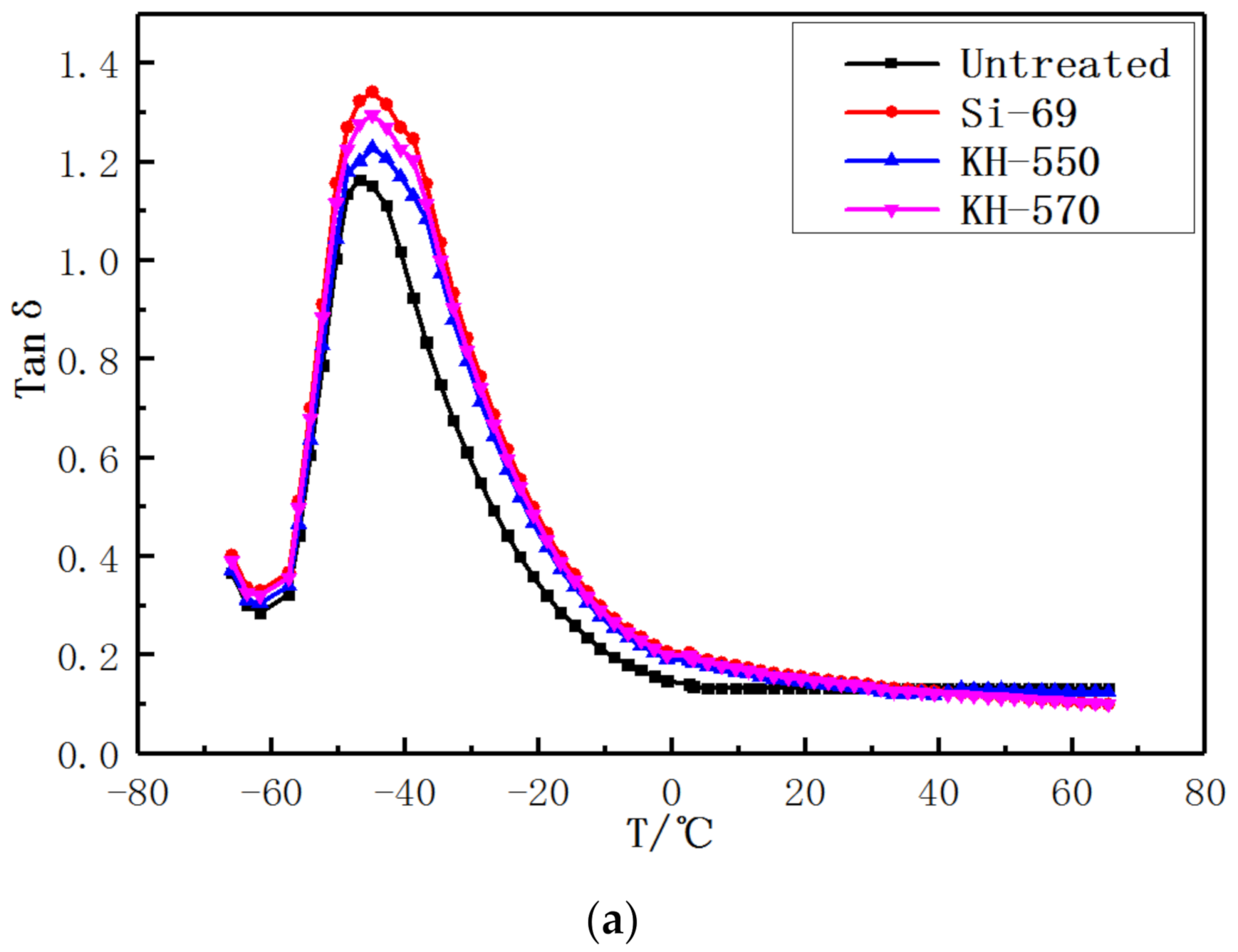
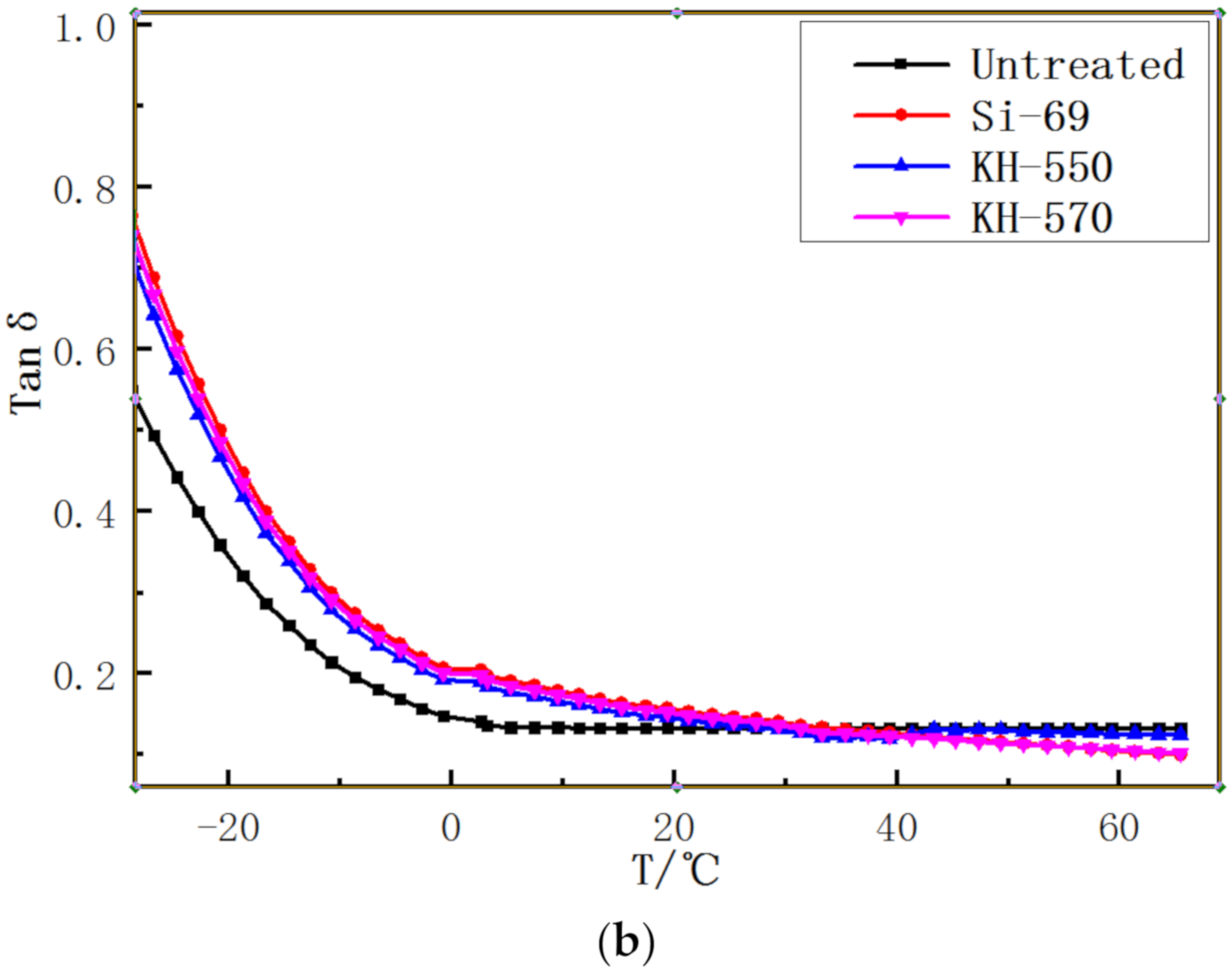

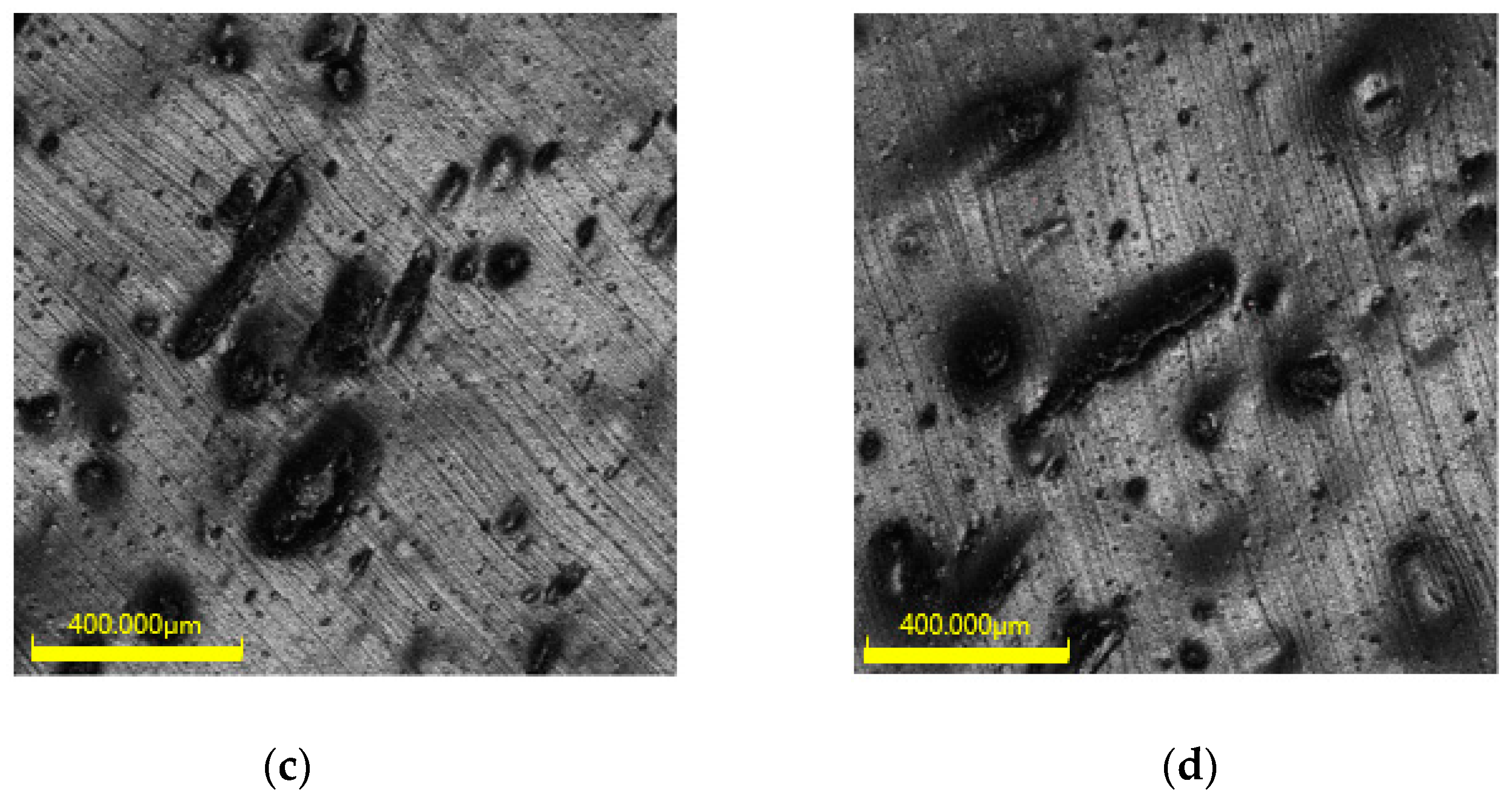
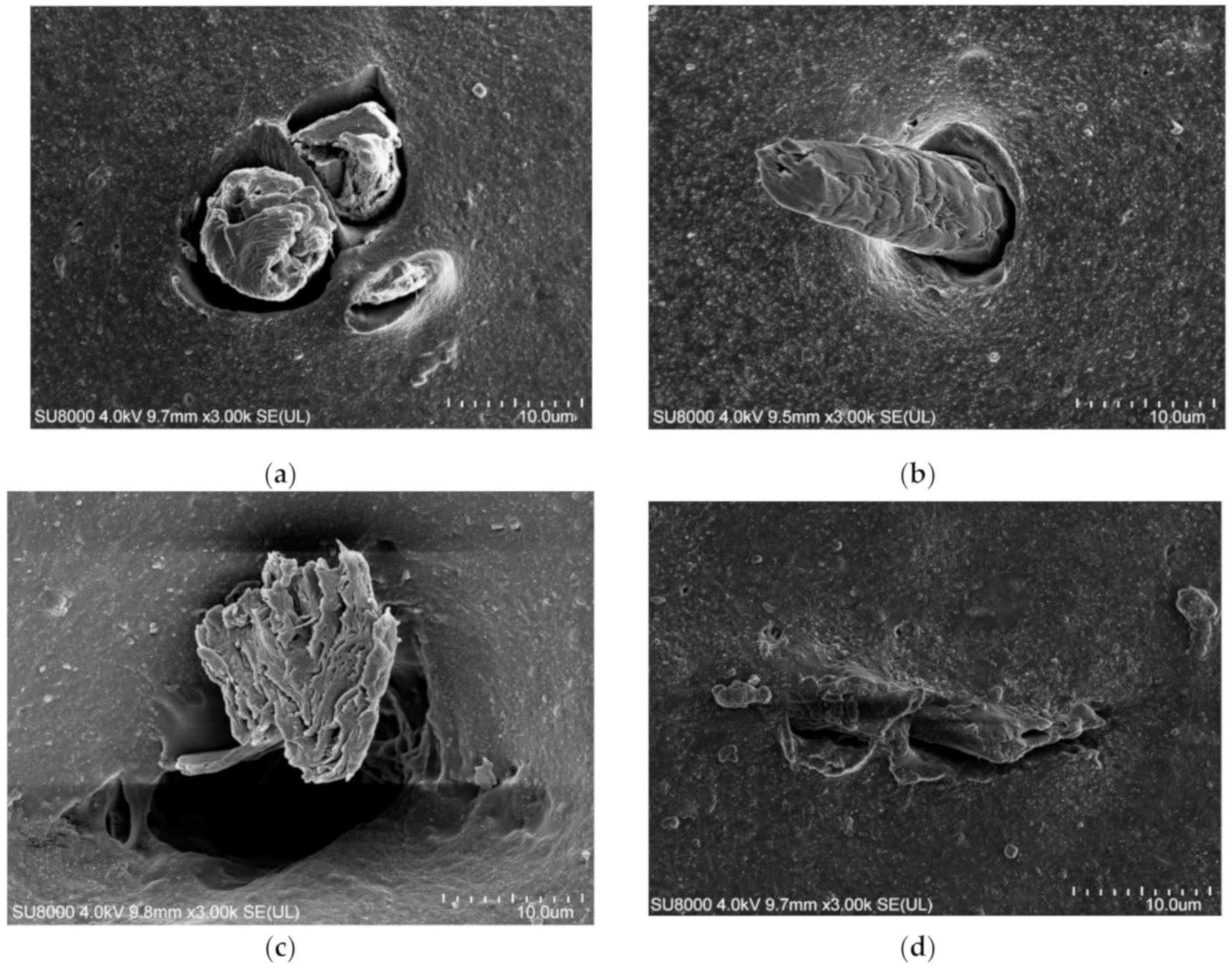
| Material | Add Copies/phr | Material | Add Copies/phr |
|---|---|---|---|
| Natural latex | 100 | areca fiber | 4 |
| Carbon black N330 | 40 | silane coupling agents | 1.5 |
| ZnO | 5 | RA−65 | 2.5 |
| SAD | 2 | CZ | 2 |
| RD | 2 | S | 2 |
| List | Preparation Process |
|---|---|
| a. | Added 4 phr areca fibers were to deionized water for 30min. After infiltration, ultrasonic vibration was carried out until areca fibers were completely dispersed. Then 100 phr natural latex was added into the areca fiber and deionized water for several times, stirring constantly during the process to prevent the fiber from agglomeration; the prepared 1.5 phr silane coupling agent was poured into the mixed areca fiber/natural rubber latex mixture, and the ultrasonic oscillation was performed again, and the high-speed vibration would break the protective layer and gel layer of latex particles, increase the contact area between rubber hydrocarbon particles and areca fiber, and make the areca fiber evenly dispersed. At the same time, silane coupling agent in this process with fiber and latex in full contact, to achieve the bonding. |
| b. | Puted the mixed solution with silane coupling agent into a large tray and flatten it to dry. The drying temperature is 60 ℃ and the time is 8 h. Finally, puted areca fiber/natural latex master-batch into the mixer, and added fillers sequentially to prepare mixed rubber. After 8 h, it was vulcanized with a plate vulcanizing machine at 150 ℃ and 150 MPa. The vulcanized rubber was stored for 12 h for performance test [12]. |
| Test List | Silane Coupling Agents | |||
|---|---|---|---|---|
| Untreated | Si−69 | KH−550 | KH−570 | |
| Mooney Viscosity [ML (1+4) 100 °C] | 43 | 42 | 43 | 44 |
| t10/min | 1.55 ± 0.02 | 3.05 ± 0.04 | 3.55 ± 0.01 | 3.21 ± 0.03 |
| t90/min | 12.63 ± 0.06 | 9.25 | 8.33 ± 0.05 | 10.42 ± 0.03 |
| ML (dN·m) | 1.95 ± 0.54 | 1.55 ± 0.43 | 2.43 ± 0.57 | 1.65 ± 0.45 |
| MH (dN·m) | 15.47 ± 0.35 | 18.41 ± 0.26 | 16.13 ± 0.31 | 16.78 ± 0.28 |
| MH–ML (dN·m) | 13.52 ± 0.19 | 16.86 ± 0.17 | 13.7 ± 0.26 | 15.13 ± 0.17 |
| Test List | Silane Coupling Agents | |||
|---|---|---|---|---|
| Untreated | Si−69 | KH−550 | KH−570 | |
| Hardness shore A/° | 52 | 53 | 51 | 54 |
| 100% modulus/MPa | 3.56 ± 1.42 | 4.45 ± 0.72 | 3.68 ± 0. 84 | 4.21 ± 0.78 |
| 300% modulus/MPa | 14.21 ± 0.96 | 16.59 ± 0.85 | 15.21 ± 1.02 | 15.43 ± 1.15 |
| Tensile strength/MPa | 22.45 ± 1.34 | 27.21 ± 0.86 | 24.66 ± 1.21 | 23.32 ± 1.26 |
| Elongation at break/% | 320.3 ± 4.2 | 443.1 ± 2.8 | 394.2 ± 3.1 | 415.4 ± 2.3 |
| Tear strength/KN·m−1 | 62 ± 2.5 | 70 ± 1.8 | 66 ± 2.3 | 68 ± 2.7 |
| Abrasion loss/cm3 | 0.115 | 0.091 | 0.103 | 0.104 |
Publisher’s Note: MDPI stays neutral with regard to jurisdictional claims in published maps and institutional affiliations. |
© 2020 by the authors. Licensee MDPI, Basel, Switzerland. This article is an open access article distributed under the terms and conditions of the Creative Commons Attribution (CC BY) license (http://creativecommons.org/licenses/by/4.0/).
Share and Cite
Pan, Y.; Zhang, M.; Zhang, J.; Zhu, X.; Bian, H.; Wang, C. Effect of Silane Coupling Agent on Modification of Areca Fiber/Natural Latex. Materials 2020, 13, 4896. https://doi.org/10.3390/ma13214896
Pan Y, Zhang M, Zhang J, Zhu X, Bian H, Wang C. Effect of Silane Coupling Agent on Modification of Areca Fiber/Natural Latex. Materials. 2020; 13(21):4896. https://doi.org/10.3390/ma13214896
Chicago/Turabian StylePan, Yiren, Meng Zhang, Jian Zhang, Xiaoyao Zhu, Huiguang Bian, and Chuansheng Wang. 2020. "Effect of Silane Coupling Agent on Modification of Areca Fiber/Natural Latex" Materials 13, no. 21: 4896. https://doi.org/10.3390/ma13214896
APA StylePan, Y., Zhang, M., Zhang, J., Zhu, X., Bian, H., & Wang, C. (2020). Effect of Silane Coupling Agent on Modification of Areca Fiber/Natural Latex. Materials, 13(21), 4896. https://doi.org/10.3390/ma13214896




